PBT+GF 物性表
- 格式:pdf
- 大小:123.72 KB
- 文档页数:3
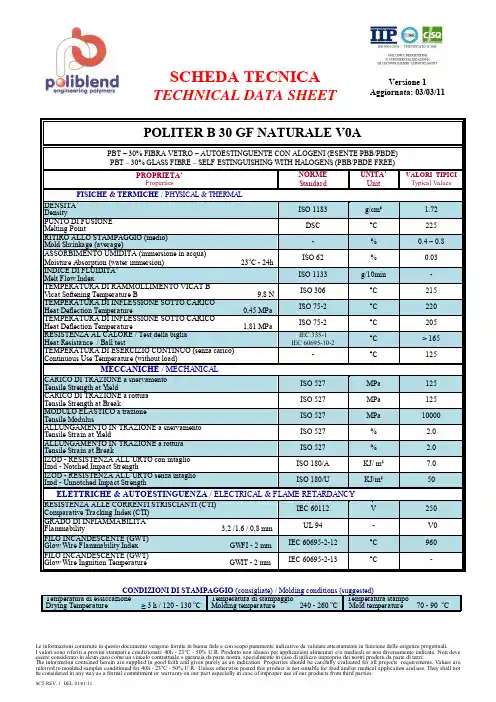

塑胶材料分类、物性表、材料特性、用途
以分子结构及特性分
以用途及使用区域分
热塑性:反复加热仍可以使用的合成树脂材料,材料在未分解、碳化下可根据材料性能进行比例回用。
常用的
热塑性材料有PVC、PS、PC、PMMA、ABS、PE、PP、POM、PA、PSU(聚矾)、SP(饱和聚脂)、PTFE
(聚四氟乙烯)。
热固性:加热初具有可溶性和可塑性,继续加热材料固化,不再具有可塑性。
前期分子呈线形结构,后期呈网
状结构,在加热过程中变化过程是不可逆的。
常见的热固性材料有PF(酚醛)、UP(不饱和聚脂)、氨基塑料
、有机硅塑料。
所有的热固性材料都是非结晶性材料,而热塑性材料中只有部分是结晶性或半结晶性。
两者之
间的最大区别就是可逆性和不可逆性,而热固性材料一般不用于民用产品,而且产量很低。
通用塑胶:产量大、用途广泛、价格低廉的塑料。
如PS、PP、PE、PU、PMMA、AS、PVC等。
成形面广,可
替代大部分其它材质,占使用材料比例的80%以上,是塑料工业的主体。
工程塑胶:具有较高的机械强度,良好的耐磨性、耐腐蚀性、自润滑性、稳定性等,可以取大代金属作机械部
件。
常用的五大工程塑胶,ABS、PC、POM、PA、(PBT)。
特殊材料:具有特殊性能的材料,如高耐热性、高电绝缘性、高不变异性、高耐腐蚀性、高抗老化性等。
专用
材料,一般普通注塑机不能使用。
材料分类。
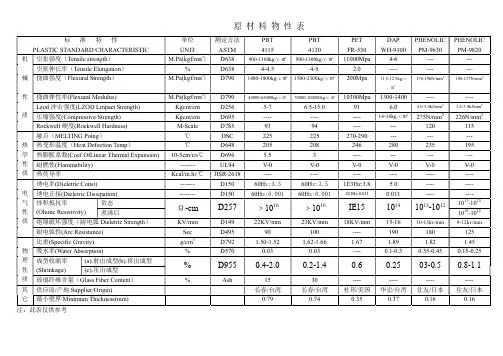



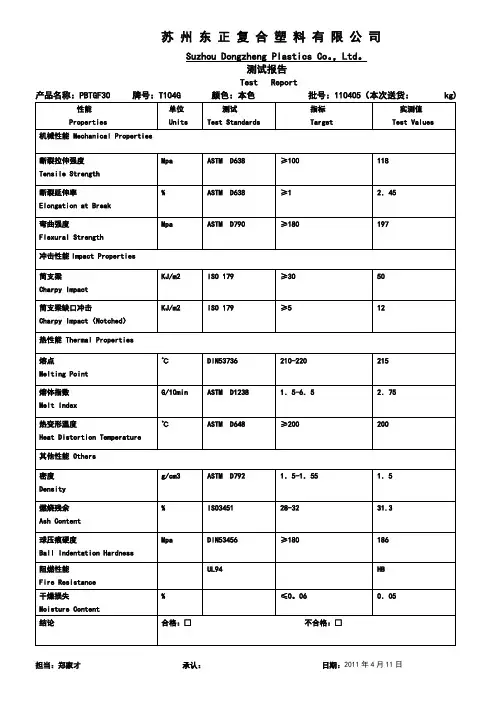
苏州东正复合塑料有限公司Suzhou Dongzheng Plastics Co。
,Ltd。
测试报告Test Report产品名称:PBTGF30 牌号:T104G 颜色:本色批号:110405(本次送货: kg)性能Properties 单位Units测试Test Standards指标Target实测值Test Values机械性能 Mechanical Properties断裂拉伸强度Tensile StrengthMpa ASTM D638 ≥100 118断裂延伸率Elongation at Break% ASTM D638 ≥1 2.45弯曲强度Flexural StrengthMpa ASTM D790 ≥180 197冲击性能Impact Properties简支梁Charpy ImpactKJ/m2 ISO 179 ≥30 50简支梁缺口冲击Charpy Impact(Notched)KJ/m2 ISO 179 ≥5 12热性能 Thermal Properties熔点Melting Point℃DIN53736 210-220 215熔体指数Melt IndexG/10min ASTM D1238 1.5-6.5 2.75热变形温度Heat Distortion Temperature℃ASTM D648 ≥200 200其他性能 Others密度Densityg/cm3 ASTM D792 1.5-1.55 1.5燃烧残余Ash Content% ISO3451 28-32 31.3球压痕硬度Ball Indentation HardnessMpa DIN53456 ≥180 186阻燃性能Fire ResistanceUL94 HB干燥损失Moisture Content% ≤0。
06 0.05 结论合格:□不合格:□担当:郑家才承认:日期:2011年4月11日熔程℃210-250 Melt Temperature Range℃220熔点Melt Temperature Optimum干燥时间h 4---6 Drying Time,Dehumidified Dryer℃110--120 干燥温度Drying Temperature干燥损失% ≤0。

宝瑞塑胶原料有限公司
W ww. P 概述材料为聚对苯二甲酸丁二醇酯(PBT),挤出级
类别:聚合物,热塑性聚酯,TP ; 聚对苯二甲酸丁二酯(PBT),聚对苯二甲酸丁二酯(PBT),挤出级
材质说明:此属性数据MatWeb的数据库类别“聚对苯二甲酸丁二酯(PBT),挤出级”总结了类似的材料。
报告的每个属性的值范围是适当MatWeb的条目的最小值和最大值。
的注释报告的平均值,用于计算平均值的数据点的数目。
值不一定是典型的任何特定的品位,尤其是不太常见的价值观和那些可以受影响最严重的添加剂或加工方法。
杜邦高性能聚合物可以是你的合作伙伴,以帮助您进行一个项目从概念到商业化。
我们的产品往往是昂贵的高性能特种聚合物和金属之间架起了一座桥梁。
泰科纳是一个以解决方案为导向的公司,采用先进的聚合物技术生产高性能塑料材料,用于。
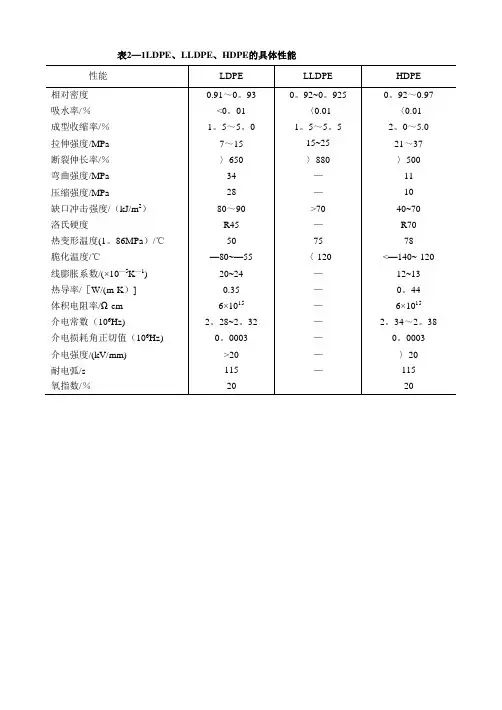
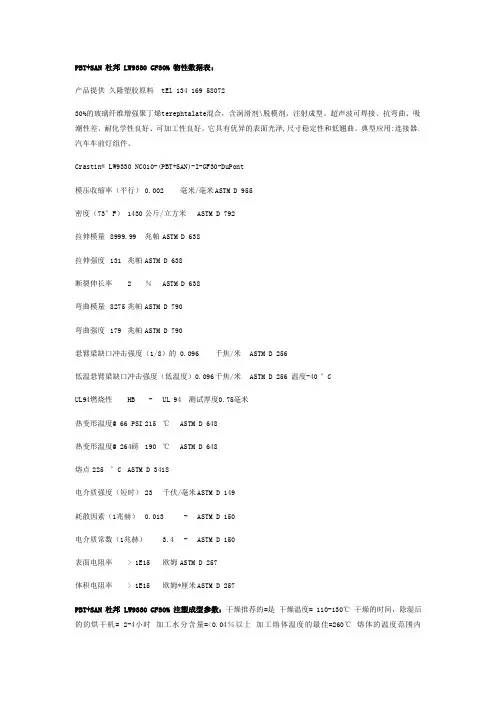
PBT+SAN杜邦LW9330GF30%物性数据表:产品提供久隆塑胶原料tEl134********30%的玻璃纤维增强聚丁烯terephtalate混合,含润滑剂\脱模剂,注射成型。
超声波可焊接、抗弯曲、吸潮性差、耐化学性良好、可加工性良好。
它具有优异的表面光泽,尺寸稳定性和低翘曲。
典型应用:连接器、汽车车前灯组件。
Crastin®LW9330NC010-(PBT+SAN)-I-GF30-DuPont模压收缩率(平行)0.002毫米/毫米ASTM D955密度(73°F)1430公斤/立方米ASTM D792拉伸模量8999.99兆帕ASTM D638拉伸强度131兆帕ASTM D638断裂伸长率2%ASTM D638弯曲模量8275兆帕ASTM D790弯曲强度179兆帕ASTM D790悬臂梁缺口冲击强度(1/8)的0.096千焦/米ASTM D256低温悬臂梁缺口冲击强度(低温度)0.096千焦/米ASTM D256温度-40°CUL94燃烧性HB-UL94测试厚度0.75毫米热变形温度@66PSI215℃ASTM D648热变形温度@264磅190℃ASTM D648熔点225°C ASTM D3418电介质强度(短时)23千伏/毫米ASTM D149耗散因素(1兆赫)0.013-ASTM D150电介质常数(1兆赫) 3.4-ASTM D150表面电阻率>1E15欧姆ASTM D257体积电阻率>1E15欧姆*厘米ASTM D257PBT+SAN杜邦LW9330GF30%注塑成型参数:干燥推荐的=是干燥温度=110-130℃干燥的时间,除湿后的的烘干机=2-4小时加工水分含量=<0.04%以上加工熔体温度的最佳=260℃熔体的温度范围内=240-260℃模具温度最佳=100℃模具的温度范围内=30-130℃。
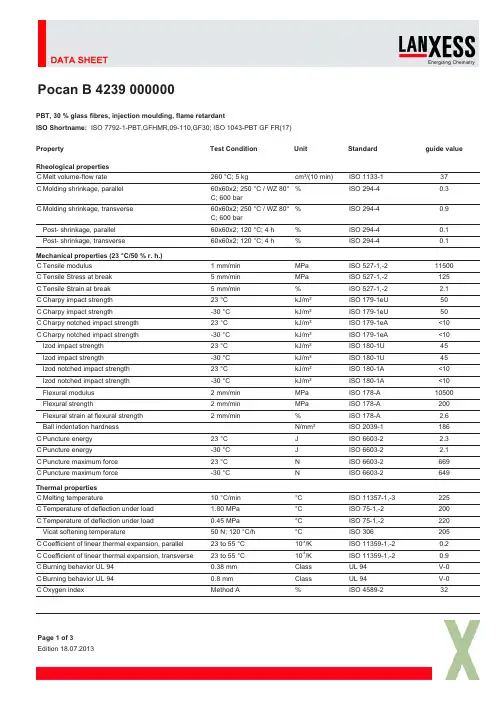
PBT,30%glass fibres,injection moulding,flame retardantISO Shortname:ISO 7792-1-PBT,GFHMR,09-110,GF30;ISO 1043-PBT GF FR(17)PropertyTest ConditionUnitStandardguide valueRheological properties C Melt volume-flow rate 260°C;5kgcm³/(10min)ISO 1133-137C Molding shrinkage,parallel 60x60x2;250°C /WZ 80°C;600bar%ISO 294-40.3C Molding shrinkage,transverse 60x60x2;250°C /WZ 80°C;600bar%ISO 294-40.9Post-shrinkage,parallel 60x60x2;120°C;4h %ISO 294-40.1Post-shrinkage,transverse60x60x2;120°C;4h%ISO 294-40.1Mechanical properties (23°C/50%r.h.)C Tensile modulus 1mm/min MPa ISO 527-1,-211500C Tensile Stress at break 5mm/min MPa ISO 527-1,-2125C Tensile Strain at break 5mm/min %ISO 527-1,-2 2.1C Charpy impact strength 23°C kJ/m²ISO 179-1eU 50C Charpy impact strength -30°C kJ/m²ISO 179-1eU 50C Charpy notched impact strength 23°C kJ/m²ISO 179-1eA <10C Charpy notched impact strength -30°C kJ/m²ISO 179-1eA <10Izod impact strength 23°C kJ/m²ISO 180-1U 45Izod impact strength -30°C kJ/m²ISO 180-1U 45Izod notched impact strength 23°C kJ/m²ISO 180-1A <10Izod notched impact strength -30°C kJ/m²ISO 180-1A <10Flexural modulus 2mm/min MPa ISO 178-A 10500Flexural strength2mm/min MPa ISO 178-A 200Flexural strain at flexural strength 2mm/min%ISO 178-A 2.6Ball indentation hardness N/mm²ISO 2039-1186C Puncture energy 23°C J ISO 6603-2 2.3C Puncture energy -30°C J ISO 6603-2 2.1C Puncture maximum force 23°C N ISO 6603-2669C Puncture maximum force -30°C NISO 6603-2649Thermal properties C Melting temperature10°C/min °C ISO 11357-1,-3225C Temperature of deflection under load 1.80MPa °C ISO 75-1,-2200C Temperature of deflection under load 0.45MPa °C ISO 75-1,-2220Vicat softening temperature50N;120°C/h °C ISO 306205C Coefficient of linear thermal expansion,parallel 23to 55°C 10-4/K ISO 11359-1,-20.2C Coefficient of linear thermal expansion,transverse 23to 55°C 10-4/K ISO 11359-1,-20.9C Burning behavior UL 940.38mm Class UL 94V-0C Burning behavior UL 940.8mm Class UL 94V-0C Oxygen indexMethod A%ISO 4589-232Pocan B 4239000000Page 1of 3PropertyTest Condition Unit Standard guide valueThermal conductivity23°CW/(m·K)ISO 83020.24Resistance to heat (ball pressure test)°C IEC 60695-10-2213Temperature index (Tensile strength)20000h °C IEC 60216-1155Halving interval (Tensile strength)°C IEC 60216-19.3Relative temperature index (Tensile strength)°C UL 746B 140Temperature index (Tensile impact strength)20000h °C IEC 60216-1130Halving interval (Tensile impact strength)°C IEC 60216-18.4Relative temperature index (Tensile impact strength)°C UL 746B 110Temperature index (Electric strength)20000h °C IEC 60216-1145Halving interval (Electric strength)°C IEC 60216-112Relative temperature index (Electric strength)°C UL 746B 125Glow wire test (GWFI)0.8mm °C IEC 60695-2-12960Glow wire test (GWIT)0.8mm °C IEC 60695-2-13725Glow wire test (GWIT) 1.6mm °C IEC 60695-2-13725Glow wire test (GWIT)3.0mm °CIEC 60695-2-13725Electrical properties (23°C/50%r.h.)C Relative permittivity 100Hz -IEC 60250 3.9C Relative permittivity 1MHz -IEC 60250 3.8C Electric strength1mm kV/mm IEC 60243-135C Comparative tracking index CTI Solution AV IEC 60112275Electrolytic corrosion RatingIEC 60426A/B 1Other properties (23°C)C Density kg/m³ISO 11831670Bulk densitykg/m³ISO 60800Processing conditions for test specimens C Injection molding-Melt temperature °C ISO 294250C Injection molding-Mold temperature °CISO 29480Processing recommendations Drying time circulating air dryer h -4-8Drying temperature circulating air dryer °C -120Residual moisture content %Acc.to Karl Fischer 0-0.02Melt temperature (Tmin -Tmax)°C -240-260Mold temperature°C-80-100C These property characteristics are taken from the CAMPUS plastics data bank and are based on the international catalogue of basic data for plastics according to ISO10350.Pocan B 4239000000Page 2of 3DisclaimerDisclaimer for sales productsThis information and our technical advice -whether verbal,in writing or by way of trials -are given in good faith but without warranty,and this also applies whereproprietary rights of third parties are involved.Our advice does not release you from the obligation to verify the information currently provided -especially that contained in our safety data and technical information sheets -and to test our products as to their suitability for the intended processes and uses.The application,use and processing of our products and the products manufactured by you on the basis of our technical advice are beyond our control and,therefore,entirely your own responsibility.Our products are sold in accordance with the current version of our General Conditions of Sale and Delivery.Test valuesUnless specified to the contrary,the values given have been established on standardized test specimens at room temperature.The figures should be regarded as guide values only and not as binding minimum values.Kindly note that,under certain conditions,the properties can be affected to a considerable extent by the design of the mould/die,the processing conditions and the coloring.Processing noteUnder the recommended processing conditions small quantities of decomposition product may be given off during processing.To preclude any risk to the health and well-being of the machine operatives,tolerance limits for the work environment must be ensured by the provision of efficient exhaust ventilation and fresh air at theworkplace in accordance with the Safety Data Sheet.In order to prevent the partial decomposition of the polymer and the generation of volatile decomposition products,the prescribed processing temperatures should not be substantially exceeded.Since excessively high temperatures are generally the result of operator error or defects in the heating system,special care and controls are essential in these areas.LANXESS DEUTSCHLAND GMBH |D -51369LEVERKUSEN ©LANXESS DeutschlandGmbHPocan B 4239000000Page 3of 3。
PBT,30%glass fibres,injection moulding,flame retardantISO Shortname:ISO 7792-1-PBT,GFHMR,09-110,GF30;ISO 1043-PBT GF FR(17)PropertyTest ConditionUnitStandardguide valueRheological properties C Melt volume-flow rate 260°C;5kgcm³/(10min)ISO 1133-137C Molding shrinkage,parallel 60x60x2;250°C /WZ 80°C;600bar%ISO 294-40.3C Molding shrinkage,transverse 60x60x2;250°C /WZ 80°C;600bar%ISO 294-40.9Post-shrinkage,parallel 60x60x2;120°C;4h %ISO 294-40.1Post-shrinkage,transverse60x60x2;120°C;4h%ISO 294-40.1Mechanical properties (23°C/50%r.h.)C Tensile modulus 1mm/min MPa ISO 527-1,-211500C Tensile Stress at break 5mm/min MPa ISO 527-1,-2125C Tensile Strain at break 5mm/min %ISO 527-1,-2 2.1C Charpy impact strength 23°C kJ/m²ISO 179-1eU 50C Charpy impact strength -30°C kJ/m²ISO 179-1eU 50C Charpy notched impact strength 23°C kJ/m²ISO 179-1eA <10C Charpy notched impact strength -30°C kJ/m²ISO 179-1eA <10Izod impact strength 23°C kJ/m²ISO 180-1U 45Izod impact strength -30°C kJ/m²ISO 180-1U 45Izod notched impact strength 23°C kJ/m²ISO 180-1A <10Izod notched impact strength -30°C kJ/m²ISO 180-1A <10Flexural modulus 2mm/min MPa ISO 178-A 10500Flexural strength2mm/min MPa ISO 178-A 200Flexural strain at flexural strength 2mm/min%ISO 178-A 2.6Ball indentation hardness N/mm²ISO 2039-1186C Puncture energy 23°C J ISO 6603-2 2.3C Puncture energy -30°C J ISO 6603-2 2.1C Puncture maximum force 23°C N ISO 6603-2669C Puncture maximum force -30°C NISO 6603-2649Thermal properties C Melting temperature10°C/min °C ISO 11357-1,-3225C Temperature of deflection under load 1.80MPa °C ISO 75-1,-2200C Temperature of deflection under load 0.45MPa °C ISO 75-1,-2220Vicat softening temperature50N;120°C/h °C ISO 306205C Coefficient of linear thermal expansion,parallel 23to 55°C 10-4/K ISO 11359-1,-20.2C Coefficient of linear thermal expansion,transverse 23to 55°C 10-4/K ISO 11359-1,-20.9C Burning behavior UL 940.38mm Class UL 94V-0C Burning behavior UL 940.8mm Class UL 94V-0C Oxygen indexMethod A%ISO 4589-232Pocan B 4239000000Page 1of 3PropertyTest Condition Unit Standard guide valueThermal conductivity23°CW/(m·K)ISO 83020.24Resistance to heat (ball pressure test)°C IEC 60695-10-2213Temperature index (Tensile strength)20000h °C IEC 60216-1155Halving interval (Tensile strength)°C IEC 60216-19.3Relative temperature index (Tensile strength)°C UL 746B 140Temperature index (Tensile impact strength)20000h °C IEC 60216-1130Halving interval (Tensile impact strength)°C IEC 60216-18.4Relative temperature index (Tensile impact strength)°C UL 746B 110Temperature index (Electric strength)20000h °C IEC 60216-1145Halving interval (Electric strength)°C IEC 60216-112Relative temperature index (Electric strength)°C UL 746B 125Glow wire test (GWFI)0.8mm °C IEC 60695-2-12960Glow wire test (GWIT)0.8mm °C IEC 60695-2-13725Glow wire test (GWIT) 1.6mm °C IEC 60695-2-13725Glow wire test (GWIT)3.0mm °CIEC 60695-2-13725Electrical properties (23°C/50%r.h.)C Relative permittivity 100Hz -IEC 60250 3.9C Relative permittivity 1MHz -IEC 60250 3.8C Electric strength1mm kV/mm IEC 60243-135C Comparative tracking index CTI Solution AV IEC 60112275Electrolytic corrosion RatingIEC 60426A/B 1Other properties (23°C)C Density kg/m³ISO 11831670Bulk densitykg/m³ISO 60800Processing conditions for test specimens C Injection molding-Melt temperature °C ISO 294250C Injection molding-Mold temperature °CISO 29480Processing recommendations Drying time circulating air dryer h -4-8Drying temperature circulating air dryer °C -120Residual moisture content %Acc.to Karl Fischer 0-0.02Melt temperature (Tmin -Tmax)°C -240-260Mold temperature°C-80-100C These property characteristics are taken from the CAMPUS plastics data bank and are based on the international catalogue of basic data for plastics according to ISO10350.Pocan B 4239000000Page 2of 3DisclaimerDisclaimer for sales productsThis information and our technical advice -whether verbal,in writing or by way of trials -are given in good faith but without warranty,and this also applies whereproprietary rights of third parties are involved.Our advice does not release you from the obligation to verify the information currently provided -especially that contained in our safety data and technical information sheets -and to test our products as to their suitability for the intended processes and uses.The application,use and processing of our products and the products manufactured by you on the basis of our technical advice are beyond our control and,therefore,entirely your own responsibility.Our products are sold in accordance with the current version of our General Conditions of Sale and Delivery.Test valuesUnless specified to the contrary,the values given have been established on standardized test specimens at room temperature.The figures should be regarded as guide values only and not as binding minimum values.Kindly note that,under certain conditions,the properties can be affected to a considerable extent by the design of the mould/die,the processing conditions and the coloring.Processing noteUnder the recommended processing conditions small quantities of decomposition product may be given off during processing.To preclude any risk to the health and well-being of the machine operatives,tolerance limits for the work environment must be ensured by the provision of efficient exhaust ventilation and fresh air at theworkplace in accordance with the Safety Data Sheet.In order to prevent the partial decomposition of the polymer and the generation of volatile decomposition products,the prescribed processing temperatures should not be substantially exceeded.Since excessively high temperatures are generally the result of operator error or defects in the heating system,special care and controls are essential in these areas.LANXESS DEUTSCHLAND GMBH |D -51369LEVERKUSEN ©LANXESS DeutschlandGmbHPocan B 4239000000Page 3of 3。